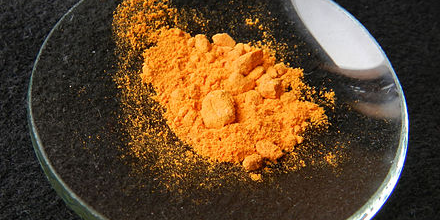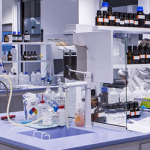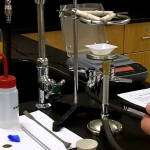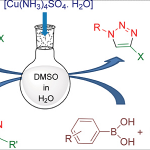Introduction
Cobalt has the outer electronic configuration 3d7 4s2and common oxidation states of cobalt include +2 and +3, although compounds with oxidation states ranging from -3 to +5 are also known. Cobalt (III) salts are difficult to prepare due the fact that Co3+ is a strong oxidizing agent and the chemistry of this oxidation state is largely that of coordination compounds. Co2+ ion is more stable than Co3+ ion for simple salts. The difficulty in this experiment is solved by air oxidation with carbon as a catalyst.
CoCl2.6H2O + 5NH3 + NH4Cl = [Co(NH3)6]Cl3 + 6H2O + H+
Aim of the Experiment
To synthesize hexaamminecobalt(III) chloride and determine the percent yield.
Apparatus and Reagents Needed
- CoCl2.6H2O
- NH3(aq)
- NH4Cl
- HCl(aq)
- Water
- Ethanol
- Activated decolourizing charcoal
- Weighing balance
- Hot water bath
- Ice bath
- Beaker
- Stirring rod
- Water aspirator
- Vacuum filtration setup
- Sample bottle
Procedures
- Weigh 10 g of ammonium chloride into a beaker and add 50 cm3 of water, stir until the solid is dissolved. Weigh 8 g of cobalt(II) chloride hexachloride into the beaker and stir till mostly dissolved.
N.B: Do the next step in a fume cupboard. - Add slowly 50 cm3 of concentrated ammonia and about 0.8 g of activated decolouring charcoal. Bubble in air into the beaker until the red solution changes into yellowish brown (approx. 4 hours).
- Filter the solution on a Buchner funnel, add the crystals and carbon to a solution of 1 mL concentrated HCl in 50 mL of water: an acidic solution. Heat the solution in hot water bath to 60-70oC then filter hot to remove the decolourizing charcoal.
- Add 10 mL of concentrated HCl to precipitate the crystals and cool to 0oC in the ice bath. Filter out the crystal using the Buchner funnel. Wash the crystals with 60% and 95% ethanol. Dry the crystals until completely free of water.
Results and Calculations
- Calculate the relative formula masses and number of moles of CoCl2.6H2O, NH3, NH4Cl used in the experiment.
- Calculate the theoretical yield in grams of [Co(NH3)6]Cl3.
- Use the recorded masses to derive the actual yield of the product.
- Use the theoretical yield and actual yield to calculate the percent yield.
-chloride-pic1.jpg)
References
- Wikipedia (2018), “Cobalt”. Retrieved from http://en.m.wikipedia.org/wiki/Cobalt (accessed 8 February 2018).
- “Chemistry 111 LaboratoryExperiment 6: Synthesis of a Coordination Compound”, retrieved from https://www.macalester.edu/~kuwata/Classes/2004-05/chem%20111/111l%20experiment%206%20-%20synthesis.pdf (accessed 8 February 2018).
- Pass, G., Sutcliffe, H. (1974), “Practical Inorganic Chemistry”, Chapman and Hall, Ltd: New York, pp. 80-81.
Download “Synthesis of Hexaamminecobalt(iii) Chloride”
SYNTHESIS-OF-HEXAAMMINECOBALT.docx – Downloaded 2 times – 22.58 KB






